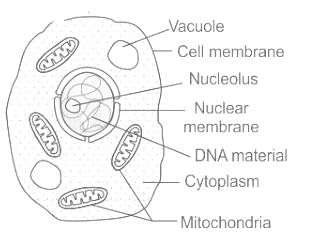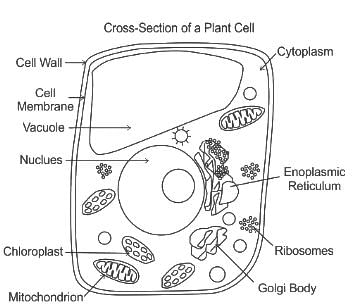Software Development Exam > Software Development Questions > Which of the following is NOT true about Cell...
Start Learning for Free
Which of the following is NOT true about Cells?
- a)Nucleus is separated from cytoplasm by a nuclear membrane.
- b)Animal cells differ from plants cells in having an additional layer around the cell membrane termed cell wall.
- c)Cells were first observed in cork by Robert Hooke in 1665.
- d)Coloured bodies called plastids are found in the plant cells only.
Correct answer is option 'B'. Can you explain this answer?
Verified Answer
Which of the following is NOT true about Cells?a)Nucleus is separated ...
The correct answer is animal cells differ from plants cells in having an additional layer around the cell membrane termed cell wall.
Key Points
- Plant cell needs cell wall whereas animal cell do not because the plants need a rigid structure so that they can grow up and out.
- This is why plant cells have an additional cell wall outside of the cell membrane.
Animal Cell:

Plant Cell:


Additional Information
- A nucleus, as related to genomics, is the membrane-enclosed organelle within a cell that contains the chromosomes.
- An array of holes, or pores, in the nuclear membrane, allows for the selective passage of certain molecules into and out of the nucleus.
- In 1665, Robert Hooke was the first to observe cork cells and their characteristic hexagonal shape.
- Robert Hooke used the first optical microscope, which was invented by him at that time.
- Plastids are double-membrane organelles which are found in the cells of plants and algae.
- Plastids are responsible for manufacturing and storing of food and often contain pigments.
Most Upvoted Answer
Which of the following is NOT true about Cells?a)Nucleus is separated ...
Understanding Cell Structure
Cells are the fundamental units of life, and understanding their structure is crucial in biology. Among the statements provided, option 'B' is incorrect regarding cell characteristics.
Explanation of Option B
- Animal and Plant Cell Differences:
- Animal cells do not have a cell wall; instead, they are surrounded by a flexible cell membrane.
- Plant cells, on the other hand, have a rigid cell wall made of cellulose, which provides structure and protection.
True Statements
- Nucleus and Cytoplasm:
- The nucleus is indeed separated from the cytoplasm by a nuclear membrane, which regulates the exchange of materials between the nucleus and the cytoplasm.
- Discovery by Robert Hooke:
- Cells were first observed in cork by Robert Hooke in 1665. He coined the term "cell" after the small box-like structures he saw under a microscope.
- Plastids in Plant Cells:
- Plastids, which are colored bodies involved in photosynthesis and storage, are primarily found in plant cells. They include chloroplasts, which are responsible for green pigmentation and energy capture.
Conclusion
In summary, option 'B' is incorrect because it misrepresents the presence of the cell wall, which is characteristic of plant cells, not animal cells. Understanding these distinctions is essential for grasping cell biology concepts.
Cells are the fundamental units of life, and understanding their structure is crucial in biology. Among the statements provided, option 'B' is incorrect regarding cell characteristics.
Explanation of Option B
- Animal and Plant Cell Differences:
- Animal cells do not have a cell wall; instead, they are surrounded by a flexible cell membrane.
- Plant cells, on the other hand, have a rigid cell wall made of cellulose, which provides structure and protection.
True Statements
- Nucleus and Cytoplasm:
- The nucleus is indeed separated from the cytoplasm by a nuclear membrane, which regulates the exchange of materials between the nucleus and the cytoplasm.
- Discovery by Robert Hooke:
- Cells were first observed in cork by Robert Hooke in 1665. He coined the term "cell" after the small box-like structures he saw under a microscope.
- Plastids in Plant Cells:
- Plastids, which are colored bodies involved in photosynthesis and storage, are primarily found in plant cells. They include chloroplasts, which are responsible for green pigmentation and energy capture.
Conclusion
In summary, option 'B' is incorrect because it misrepresents the presence of the cell wall, which is characteristic of plant cells, not animal cells. Understanding these distinctions is essential for grasping cell biology concepts.

|
Explore Courses for Software Development exam
|

|
Question Description
Which of the following is NOT true about Cells?a)Nucleus is separated from cytoplasm by a nuclear membrane.b)Animal cells differ from plants cells in having an additional layer around the cell membrane termed cell wall.c)Cells were first observed in cork by Robert Hooke in 1665.d)Coloured bodies called plastids are found in the plant cells only.Correct answer is option 'B'. Can you explain this answer? for Software Development 2025 is part of Software Development preparation. The Question and answers have been prepared according to the Software Development exam syllabus. Information about Which of the following is NOT true about Cells?a)Nucleus is separated from cytoplasm by a nuclear membrane.b)Animal cells differ from plants cells in having an additional layer around the cell membrane termed cell wall.c)Cells were first observed in cork by Robert Hooke in 1665.d)Coloured bodies called plastids are found in the plant cells only.Correct answer is option 'B'. Can you explain this answer? covers all topics & solutions for Software Development 2025 Exam. Find important definitions, questions, meanings, examples, exercises and tests below for Which of the following is NOT true about Cells?a)Nucleus is separated from cytoplasm by a nuclear membrane.b)Animal cells differ from plants cells in having an additional layer around the cell membrane termed cell wall.c)Cells were first observed in cork by Robert Hooke in 1665.d)Coloured bodies called plastids are found in the plant cells only.Correct answer is option 'B'. Can you explain this answer?.
Which of the following is NOT true about Cells?a)Nucleus is separated from cytoplasm by a nuclear membrane.b)Animal cells differ from plants cells in having an additional layer around the cell membrane termed cell wall.c)Cells were first observed in cork by Robert Hooke in 1665.d)Coloured bodies called plastids are found in the plant cells only.Correct answer is option 'B'. Can you explain this answer? for Software Development 2025 is part of Software Development preparation. The Question and answers have been prepared according to the Software Development exam syllabus. Information about Which of the following is NOT true about Cells?a)Nucleus is separated from cytoplasm by a nuclear membrane.b)Animal cells differ from plants cells in having an additional layer around the cell membrane termed cell wall.c)Cells were first observed in cork by Robert Hooke in 1665.d)Coloured bodies called plastids are found in the plant cells only.Correct answer is option 'B'. Can you explain this answer? covers all topics & solutions for Software Development 2025 Exam. Find important definitions, questions, meanings, examples, exercises and tests below for Which of the following is NOT true about Cells?a)Nucleus is separated from cytoplasm by a nuclear membrane.b)Animal cells differ from plants cells in having an additional layer around the cell membrane termed cell wall.c)Cells were first observed in cork by Robert Hooke in 1665.d)Coloured bodies called plastids are found in the plant cells only.Correct answer is option 'B'. Can you explain this answer?.
Solutions for Which of the following is NOT true about Cells?a)Nucleus is separated from cytoplasm by a nuclear membrane.b)Animal cells differ from plants cells in having an additional layer around the cell membrane termed cell wall.c)Cells were first observed in cork by Robert Hooke in 1665.d)Coloured bodies called plastids are found in the plant cells only.Correct answer is option 'B'. Can you explain this answer? in English & in Hindi are available as part of our courses for Software Development.
Download more important topics, notes, lectures and mock test series for Software Development Exam by signing up for free.
Here you can find the meaning of Which of the following is NOT true about Cells?a)Nucleus is separated from cytoplasm by a nuclear membrane.b)Animal cells differ from plants cells in having an additional layer around the cell membrane termed cell wall.c)Cells were first observed in cork by Robert Hooke in 1665.d)Coloured bodies called plastids are found in the plant cells only.Correct answer is option 'B'. Can you explain this answer? defined & explained in the simplest way possible. Besides giving the explanation of
Which of the following is NOT true about Cells?a)Nucleus is separated from cytoplasm by a nuclear membrane.b)Animal cells differ from plants cells in having an additional layer around the cell membrane termed cell wall.c)Cells were first observed in cork by Robert Hooke in 1665.d)Coloured bodies called plastids are found in the plant cells only.Correct answer is option 'B'. Can you explain this answer?, a detailed solution for Which of the following is NOT true about Cells?a)Nucleus is separated from cytoplasm by a nuclear membrane.b)Animal cells differ from plants cells in having an additional layer around the cell membrane termed cell wall.c)Cells were first observed in cork by Robert Hooke in 1665.d)Coloured bodies called plastids are found in the plant cells only.Correct answer is option 'B'. Can you explain this answer? has been provided alongside types of Which of the following is NOT true about Cells?a)Nucleus is separated from cytoplasm by a nuclear membrane.b)Animal cells differ from plants cells in having an additional layer around the cell membrane termed cell wall.c)Cells were first observed in cork by Robert Hooke in 1665.d)Coloured bodies called plastids are found in the plant cells only.Correct answer is option 'B'. Can you explain this answer? theory, EduRev gives you an
ample number of questions to practice Which of the following is NOT true about Cells?a)Nucleus is separated from cytoplasm by a nuclear membrane.b)Animal cells differ from plants cells in having an additional layer around the cell membrane termed cell wall.c)Cells were first observed in cork by Robert Hooke in 1665.d)Coloured bodies called plastids are found in the plant cells only.Correct answer is option 'B'. Can you explain this answer? tests, examples and also practice Software Development tests.

|
Explore Courses for Software Development exam
|

|
Signup for Free!
Signup to see your scores go up within 7 days! Learn & Practice with 1000+ FREE Notes, Videos & Tests.























